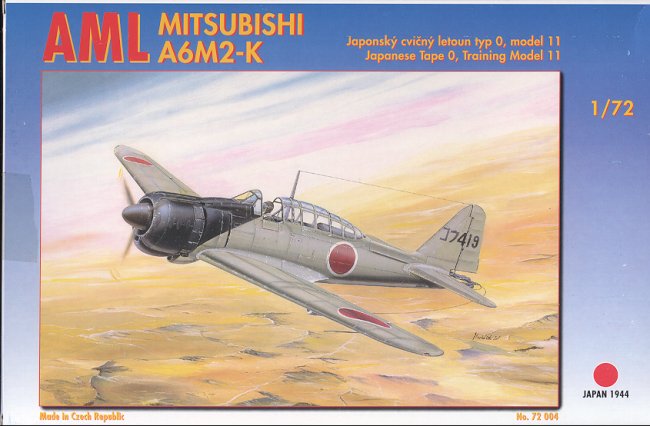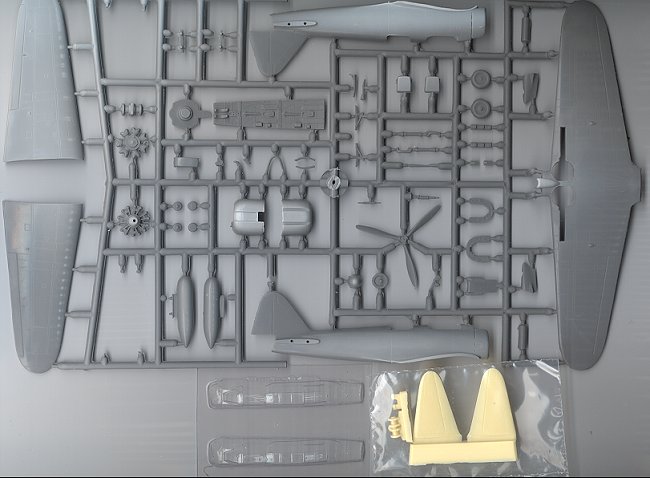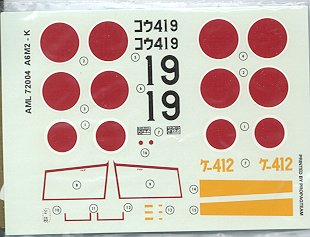
|
KIT: |
AML 1/72 A6M2-K Zero |
|
KIT # |
72004 |
|
PRICE: |
$16.95 |
|
DECALS: |
Two Aircraft |
|
REVIEW & |
|
|
NOTES: |
Short run kit with resin & photoetch parts |

|
HISTORY |
Many of the fighting powers during WWII utilized trainers made from front-line fighters. Such was the Yak-7, Bf-109G-12 and the TP-40. In Japan, the most produced were the A6M2-K and A6M5-K aircraft. These aircraft gave new fighter pilots a chance to learn how to fly these aircraft with an experienced instructor pilot rather than being 'thrown to the wolves' so to speak.
Much of the original A6M2 airframe was retained as this gave the best feel for the operational fighter. The first airframe was completed in late 1943. The major differences were the second cockpit with controls as well as the elongated canopy section and two small strakes just in front of the horizontal stabilizers. These were there to help improve spin recovery. Other changes were the removal of wing weapons and landing gear doors. A total of 508 A6M2-K aircraft were built. Along a similar line, the same was started with the A6M5 airframe, but only 7 of those were completed by the end of the war. While my reference does not state as such, I would think that all of these aircraft would be conversions of existing airframes rather than new builds.
|
THE KIT |

 This is the first AML kit I have ever bought/seen
and it looks quite familiar. Much like just about any other Czech short run kit.
However, this one has several positive features such as two vac canopies and
small sprue attachment points. The detailing is very good as one would expect
from modern kits. The parts all have flash or large mold seams that will need to
be cleaned off prior to construction. There is also a nice fret of photo
etched parts, most of which are for the interior or wheel wells. For those of
you that are doing a target tug version, you have the framework of the tail
wheel assembly that is done in photo etch, otherwise you can use the normal
tailcone. Interestingly, the horizontal stabilizers are done in resin along with
part of the target towing apparatus. For those concerned about interior detail
there is very nice detail on the insides of the fuselage halves that
should be quite visible after painting and drybrushing.
This is the first AML kit I have ever bought/seen
and it looks quite familiar. Much like just about any other Czech short run kit.
However, this one has several positive features such as two vac canopies and
small sprue attachment points. The detailing is very good as one would expect
from modern kits. The parts all have flash or large mold seams that will need to
be cleaned off prior to construction. There is also a nice fret of photo
etched parts, most of which are for the interior or wheel wells. For those of
you that are doing a target tug version, you have the framework of the tail
wheel assembly that is done in photo etch, otherwise you can use the normal
tailcone. Interestingly, the horizontal stabilizers are done in resin along with
part of the target towing apparatus. For those concerned about interior detail
there is very nice detail on the insides of the fuselage halves that
should be quite visible after painting and drybrushing.
 The instructions are more than
adequate for completing the kit. There are 16 construction steps. Color callouts
are given throughout construction and the reference chart is keyed to Humbrol
paints. There are two color schemes given. One is the box art aircraft and that
is shown as an overall light grey with black cowling and anti-glare panel. The
second aircraft has green uppers and light grey undersides. Frankly, I had
thought that trainer aircraft were to have been painted overall orange or at
least with orange undersides. Perhaps a reader can shed some more light on this.
The decals are superbly done and by Propagteam. As with all Propagteam decals,
one needs to be very careful when applying them as they are quite thin.
The instructions are more than
adequate for completing the kit. There are 16 construction steps. Color callouts
are given throughout construction and the reference chart is keyed to Humbrol
paints. There are two color schemes given. One is the box art aircraft and that
is shown as an overall light grey with black cowling and anti-glare panel. The
second aircraft has green uppers and light grey undersides. Frankly, I had
thought that trainer aircraft were to have been painted overall orange or at
least with orange undersides. Perhaps a reader can shed some more light on this.
The decals are superbly done and by Propagteam. As with all Propagteam decals,
one needs to be very careful when applying them as they are quite thin.
It is nice to see this aircraft in 1/72 as it is the one major variant missing from my Zero collection.
|
REFERENCES |
Japanese Aircraft of the Pacific War by Rene J Francillon
Review kit courtesy of me and my wallet!
If you would like your product reviewed fairly and quickly by a site that averages over 2,200 visits a day, please contact me or see other details in the Note to Contributors.